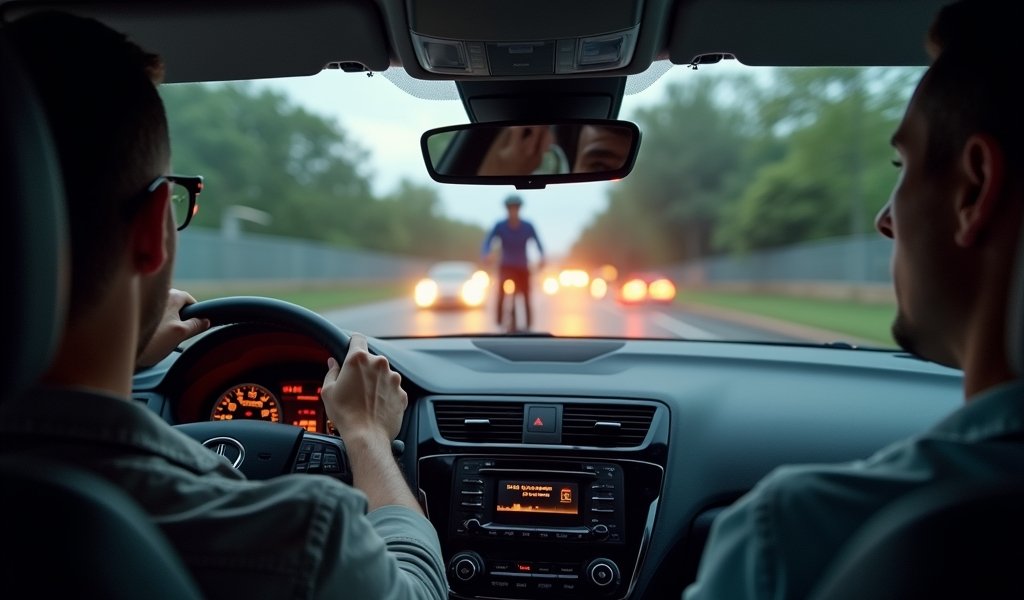Overview
Automatic Emergency Braking (AEB) systems use sensors to detect potential collisions and automatically apply brakes when a critical threshold is crossed, typically when impact would occur within 1.5 seconds. While these systems significantly reduce rear-end collisions by up to 40%, they have limitations in bad weather, with crossing traffic, and at high speeds, making regular maintenance of sensors and proper understanding of the technology essential for optimal safety performance.
Table of Contents
- Understanding Automatic Emergency Braking Threshold
- What Is Automatic Emergency Braking?
- How Automatic Emergency Braking Systems Actually Work
- The Critical Threshold: When Your Car Decides to Stop
- Factors Affecting AEB Threshold Sensitivity
- Testing Standards and Real-World Performance
- Limitations and Common Misconceptions
- Maintenance Tips for Optimal AEB Performance
- Future Developments in AEB Technology
- Conclusion
- Frequently Asked Questions
Understanding Automatic Emergency Braking Threshold
Picture this: you’re cruising down the highway, sipping coffee, jamming to your favorite tune when suddenly—the car ahead of you stops dead in its tracks. Before you even have time to spill that coffee, your vehicle screeches to a halt all by itself. Welcome to the magical world of automatic emergency braking! The hero of this story? The automatic emergency braking threshold—that critical moment when your car decides it’s time to save your bacon.
As a mechanic who’s seen the aftermath of “I thought I had more time” accidents, let me tell you—understanding the automatic emergency braking threshold isn’t just car-geek trivia. It could be the difference between a normal day and one that ends with an insurance claim form. This invisible line in the sand determines when your vehicle transforms from passive passenger to active lifesaver.
What Is Automatic Emergency Braking?
Automatic Emergency Braking (AEB) is essentially your car’s guardian angel with a heavy foot. It’s a safety system that MONITORS the road ahead, DETECTS potential collisions, and SLAMS on the brakes when you’re too busy wondering if you left the garage door open. Unlike your high school driving instructor, this system never sleeps, never gets distracted, and never asks you to turn down your music.
Think of AEB as having a tiny, hyper-vigilant driver living inside your dashboard. This little fellow has just one job: prevent you from rear-ending that minivan because you were reaching for a french fry. Using an arsenal of sensors—cameras, radar, lidar, or sometimes all three—AEB systems keep a constant electronic eye on the road ahead, measuring distances between vehicles and calculating collision risks in real-time.
But here’s where things get interesting—and where professional car diagnostics come into play. Not all AEB systems are created equal. Some are as sensitive as a poet during a full moon, while others are more laid-back than a surfer catching waves on a Sunday. The difference lies in their thresholds—the invisible trigger point where the system stops politely suggesting you might want to brake and takes matters into its own metallic hands.

How Automatic Emergency Braking Systems Actually Work
Let me break down how these mechanical guardian angels operate. Imagine having that one friend who’s ALWAYS pointing out potential dangers—”Watch out for that pothole!” “That car’s stopping!” That’s your AEB system, except it’s actually helpful and doesn’t make you want to leave it at the next rest stop.
At its core, AEB constantly calculates what engineers call Time-To-Collision (TTC). This is essentially your car doing math problems at lightning speed: “If I’m going 40 mph and that obstacle is 100 feet away and not moving, we’ll kiss metal in approximately 1.7 seconds.” When that number gets uncomfortably small, your car springs into action with a choreographed series of responses.
First comes the warning phase—lights flash, alarms beep, and sometimes your seat or steering wheel vibrates like you’ve driven over a rumble strip made of caffeine. If you don’t respond quickly enough (and let’s be honest, many of us don’t), the system pre-charges the brakes, reducing the stopping distance once you do hit the pedal. Still not paying attention? That’s when the automatic emergency braking threshold is crossed, and the system says “I’ll do it myself” in whatever language cars speak, applying partial or full braking force depending on the situation’s urgency.
The Critical Threshold: When Your Car Decides to Stop
Now let’s talk about that magical moment—the automatic emergency braking threshold. This isn’t some arbitrary line drawn by engineers who had too much coffee. It’s a carefully calculated point of no return, a digital Rubicon that, once crossed, means your car is taking control whether you like it or not. Have you ever wondered why sometimes your car practically screams at you about an impending collision but doesn’t actually brake? That’s the threshold at work!
Most systems operate on a multi-stage threshold concept. Think of it as your car’s anxiety level: mild concern (warning only), moderate panic (brake preparation), and full-blown automotive anxiety attack (automatic emergency braking engaged). According to research from the Insurance Institute for Highway Safety, most systems trigger full braking when the Time-To-Collision drops below 1.5 seconds, though this varies by manufacturer and model year.
What makes this fascinating is how the threshold adapts based on your speed. At highway velocities, the system needs more lead time and distance—it might begin warnings when you’re 300 feet from an obstacle. In stop-and-go traffic, the threshold compresses accordingly. It’s like having a co-pilot whose risk assessment skills change based on the driving environment. And just like with adaptive cruise control calibration, getting these thresholds right is a delicate balancing act between safety and avoiding false alarms.
Factors Affecting AEB Threshold Sensitivity
You might think your car’s automatic emergency braking threshold is set in stone, like your uncle’s political opinions at Thanksgiving dinner. Not so! These thresholds are remarkably dynamic, adjusting faster than a chameleon on a disco floor. Weather conditions are perhaps the biggest variable—rain, snow, and fog can all reduce sensor effectiveness, causing the system to become either more conservative (braking earlier) or less reliable (missing obstacles altogether).
Vehicle speed plays a massive role too. At higher speeds, physics becomes your enemy—stopping distances increase exponentially, not linearly. This means your AEB system might trigger much earlier when you’re doing 65 mph compared to 25 mph. It’s simple math: the faster you go, the sooner your car needs to make that life-saving decision. And let’s not forget about the condition of your brakes and tires! Even the most sophisticated AEB system can’t overcome the laws of physics if your tires are balder than your high school chemistry teacher.
Interestingly, even the type of obstacle matters. Most AEB systems are calibrated primarily for detecting other vehicles—they’re essentially playing a continuous game of “one of these things is shaped like a car.” Pedestrians, cyclists, and animals present different detection challenges. This is why some vehicles advertise “Pedestrian Detection” as a separate feature—it requires additional algorithms to identify the uniquely unpredictable movements of humans on foot. The next time your car beeps at you for no apparent reason, there’s probably a squirrel philosopher contemplating life in the middle of the road that you missed.

Testing Standards and Real-World Performance
Ever wonder who decides if your car’s automatic emergency braking threshold is too sensitive or about as responsive as a teenager asked to do chores? Enter the testing organizations! The European New Car Assessment Programme (Euro NCAP) and the Insurance Institute for Highway Safety (IIHS) have developed standardized tests that put AEB systems through their paces. These tests involve scenarios that would make any driving instructor reach for the emergency brake—approaching stopped vehicles, cars braking suddenly, and pedestrians stepping into traffic with all the self-preservation instinct of a lemming.
But—and this is a BIG but—laboratory testing doesn’t always match real-world performance. It’s like the difference between practicing your dance moves alone in your bedroom versus performing on stage with actual people watching. In controlled tests, the lighting is perfect, the test dummies move predictably, and there’s no glare from the sun or confusing roadway markings. In the real world? Well, let’s just say complications arise faster than plot twists in a telenovela.
According to a study by the National Highway Traffic Safety Administration, vehicles equipped with AEB systems show a 40% reduction in rear-end crashes. That’s impressive! But that still means 60% of potential crashes aren’t prevented. Why? Sometimes it’s because the system’s threshold wasn’t crossed until too late. Other times, it’s because environmental factors threw the sensors off their game. The lesson here? Don’t treat your AEB system like a superhero with infallible powers—it’s more like a well-meaning assistant who occasionally misplaces important files.
Limitations and Common Misconceptions
Let’s shatter some illusions about automatic emergency braking thresholds, shall we? First and foremost: your AEB is NOT a substitute for paying attention! I’ve had clients roll into my shop with crumpled bumpers, completely bewildered because “the car was supposed to stop itself.” This is like expecting your umbrella to also act as a parachute—it’s asking too much of a system with specific design parameters.
One of the biggest misconceptions is that AEB works equally well in all scenarios. Not true! Most systems struggle mightily with crossing traffic (vehicles moving perpendicular to your path) because the relative velocity calculations become exponentially more complex. Think about trying to catch a football thrown straight at you versus one thrown across your field of vision—it’s the same principle. Your automatic emergency braking threshold might never trigger for a car running a red light from your right or left because the system simply wasn’t designed for that scenario.
Weather and lighting conditions create another major limitation. Heavy rain can cause radar signals to bounce erratically. Low sun can blind cameras. Snow can cover sensors. Even something as mundane as road salt residue can render your sophisticated collision avoidance system about as useful as a chocolate teapot. And here’s a fun fact that manufacturers rarely advertise: most AEB systems become significantly less reliable above 50 mph and may shut down entirely at higher speeds. Why? Because the physics of stopping a two-ton vehicle from highway speeds require more distance than the sensors can reliably cover. Remember folks, AEB is a safety supplement, not a replacement for the most sophisticated collision-avoidance system ever created—the attentive human driver!
Maintenance Tips for Optimal AEB Performance
Want your automatic emergency braking threshold to work as advertised when it matters most? Then listen up—your AEB system needs TLC just like the rest of your vehicle. NEVER ignore those pesky warning lights on your dashboard! If your AEB or forward collision warning light illuminates, it’s not just being dramatic—your safety system is literally telling you it can’t do its job properly. This isn’t something to address “eventually” unless you want “eventually” to involve exchanging insurance information with a stranger.
Keep those sensors clean! Your AEB system “sees” through cameras, radar units, and sometimes lidar sensors typically located in your front grille, bumper, or behind the windshield near your rearview mirror. Road grime, bug splatter, and winter salt build-up can blind these electronic eyes faster than you can say “why didn’t my car stop?” Make sensor cleaning part of your regular car wash routine. And speaking of windshields—if you need a replacement, be prepared for sticker shock. Many modern windshields contain embedded cameras or sensors that require recalibration after replacement, turning what used to be a simple repair into a high-tech procedure.
Regular system checks are crucial, especially if you’ve been in even a minor fender bender. That little parking lot tap could have knocked your sensors out of alignment by just a few millimeters—enough to throw off their calculations and alter your automatic emergency braking threshold. Diagnostic tools like those used in smart car diagnostics can identify issues before they become safety concerns. Consider it preventive medicine for your car’s brain. Remember: an ounce of maintenance prevents a ton of collision repair!
Future Developments in AEB Technology
Hold onto your steering wheels, folks—the future of automatic emergency braking threshold technology is evolving faster than fashion trends at a high school reunion! We’re rapidly approaching a world where your car won’t just detect obstacles but will predict behaviors. Imagine your vehicle calculating that the driver ahead is showing erratic patterns suggesting distraction or impairment, and adjusting its threshold accordingly. That’s not science fiction—it’s already in development stages.
Machine learning is revolutionizing how these systems operate. Instead of relying on pre-programmed thresholds, next-generation AEB systems will learn from collective driving data, constantly refining their algorithms. Think of it as crowd-sourced safety! Your car’s close call today becomes learning data that improves every other connected vehicle’s response tomorrow. Vehicle-to-vehicle communication will also dramatically enhance threshold accuracy. When cars talk directly to each other, sharing position, speed, and intention data, the guesswork disappears from collision prediction.
The holy grail? Contextual awareness. Future systems won’t just detect that there’s an object ahead—they’ll understand what it is, its likely behavior patterns, and the surrounding environment. A child’s ball rolling into the street will trigger different threshold calculations than a plastic bag blowing across the road. Your car will essentially develop situation-specific intuition. Companies like Waymo and Mobileye are already implementing early versions of these systems. The automatic emergency braking threshold is evolving from a simple distance-speed calculation into a sophisticated risk assessment algorithm that considers dozens of variables in milliseconds. The question isn’t if your car will become smarter about when to take control—it’s how soon.
Conclusion
The automatic emergency braking threshold represents that critical moment when technology steps in to save us from our human limitations—whether that’s distraction, delayed reaction times, or misjudgment. It’s the digital line in the sand between a normal drive and a potential collision. As we’ve explored, this threshold isn’t a simple on/off switch but a complex calculation involving speed, distance, obstacle type, environmental conditions, and numerous other factors.
Understanding how and when your vehicle’s AEB system activates empowers you to work with this technology rather than against it or, worse, depending on it blindly. Remember, even the most advanced systems have limitations—they’re supplements to attentive driving, not replacements for it.
As AEB technology continues to evolve, we can expect more sophisticated, contextually aware systems that better understand the unpredictable world of roadway dynamics. But for now, maintain your sensors, respond promptly to warning signals, and keep your automatic emergency braking system properly calibrated through regular professional checks.
Your car’s ability to make split-second braking decisions might just be the difference between a near-miss story and a collision repair bill—or something far more serious. Treat your AEB system with respect, understand its threshold limitations, and it will serve as your faithful co-pilot on the journey ahead.
Frequently Asked Questions
What exactly is the automatic emergency braking threshold?
It’s the critical point at which your vehicle’s AEB system determines a collision is imminent and automatically applies the brakes. This threshold is typically calculated based on time-to-collision, usually triggering when impact would occur within 1.5 seconds.
Can automatic emergency braking prevent all types of collisions?
No, AEB systems are primarily designed to prevent or mitigate rear-end collisions. Most systems have limited effectiveness with crossing traffic, pedestrians, or obstacles that appear suddenly from the side.
Will my AEB system work in bad weather?
AEB systems have reduced effectiveness in adverse weather conditions like heavy rain, snow, or fog. These conditions can interfere with sensors and cameras, potentially raising thresholds or disabling the system entirely.
Do I need to maintain my automatic emergency braking system?
Absolutely! Keep sensors and cameras clean, respond to any warning lights, and have the system calibrated after windshield replacements or front-end repairs. Even minor bumper damage can affect sensor alignment.
Can I turn off my automatic emergency braking system if I find it too sensitive?
Most vehicles allow you to adjust sensitivity levels or temporarily disable AEB, but manufacturers and safety experts strongly advise against turning it off. Statistics show that vehicles with active AEB systems are involved in significantly fewer rear-end collisions.

